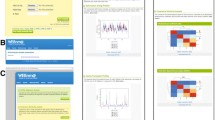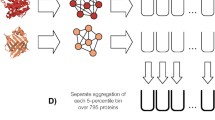Abstract
We investigate several approaches to coarse grained normal mode analysis on protein residual-level structural fluctuations by choosing different ways of representing the residues and the forces among them. Single-atom representations using the backbone atoms C α , C, N, and C β are considered. Combinations of some of these atoms are also tested. The force constants between the representative atoms are extracted from the Hessian matrix of the energy function and served as the force constants between the corresponding residues. The residue mean-square-fluctuations and their correlations with the experimental B-factors are calculated for a large set of proteins. The results are compared with all-atom normal mode analysis and the residue-level Gaussian Network Model. The coarse-grained methods perform more efficiently than all-atom normal mode analysis, while their B-factor correlations are also higher. Their B-factor correlations are comparable with those estimated by the Gaussian Network Model and in many cases better. The extracted force constants are surveyed for different pairs of residues with different numbers of separation residues in sequence. The statistical averages are used to build a refined Gaussian Network Model, which is able to predict residue-level structural fluctuations significantly better than the conventional Gaussian Network Model in many test cases.







Similar content being viewed by others
References
Ahmed, A., & Gohlke, H. (2006). Multiscale modeling of macromolecular conformational changes combining concepts from rigidity and elastic network theory. Proteins, 63, 1038–1051.
Bahar, I., Atilgan, A. R., & Erman, B. (1997). Direct evaluation of thermal fluctuations in proteins using a single-parameter harmonic potential, folding &. Design, 2, 173–181.
Bahar, I., Atilgan, A. R., Demirel, M., & Erman, B. (1998). Vibrational dynamics of folded proteins: significance of slow and fast motions in relation to function and stability. Phys. Rev. Lett., 80, 2733–2736.
Berg, J. M., Tymoczko, J. L., & Stryer, L. (2006). Biochemistry. New York: Freeman.
Berman, H., et al. (2010) Pdb data bank annual report. http://www.rcsb.orgpdb.
Brooks, B. R., & Karplus, M. (1983). Harmonic dynamics of proteins: normal mode and fluctuations in bovine pancreatic trypsin inhibitor. Proc. Natl. Acad. Sci. USA, 80, 6571–6575.
Brooks, C. L. III, Karplus, M., & Pettitt, B. M. (1989). Proteins: a theoretical perspective of dynamics, structure, and thermodynamics. New York: Wiley.
Brooks, B. R., et al. (2009). CHARMM: the biomolecular simulation program. J. Comput. Chem., 30, 1545–1614.
Cui, Q., & Bahar, I. (2006). Normal mode analysis: theory and application to biological and chemical systems. London/Boca Raton: Chapman & Hall/CRC Press.
Demerdash, O. N. A., & Mitchell, J. C. (2012). Density-cluster NMA: a new protein decomposition technique for coarse-grained normal mode analysis. Proteins, 80, 1766–1779.
Drenth, J. (2006). Principles of protein X-ray crystallography. Berlin: Springer.
Go, N., Noguti, T., & Nishikawa, T. (1983). Dynamics of a small globular protein in terms of low-frequency vibrational modes. Proc. Natl. Acad. Sci. USA, 80, 3696–3700.
Haliloglu, T., Bahar, I., & Erman, B. (1997). Gaussian dynamics of folded proteins. Phys. Rev. Lett., 79, 3090–3092.
Huang, Y., Bonett, S., Kloczkowski, A., Jernigan, R., & Wu, Z. (2011). Statistical measures on protein residue-level structural properties. J. Struct. Funct. Genomics, 12, 119–136.
Jacobs, D. J., Rader, A. J., Kuhn, L. A., & Thorpe, M. F. (2001). Protein flexibility predictions using graph theory. Proteins, 44, 150–165.
Kondrashov, D., Cui, Q., & Phillips, G. Jr. (2006). Optimization and evaluation of a coarse-grained model of protein motion using X-ray crystal data. Biophys. J., 91, 2760–2767.
Kuszewski, J., Gronenborn, A. M., & Clore, G. M. (1996). Improving the quality of NMR and crystallographic protein structures by means of a conformational database potential derived from structure databases. Protein Sci., 5, 1067–1080.
Levitt, M., Sander, C., & Stern, P. S. (1985). Protein normal-mode dynamics: trypsin inhibitor, crambin, ribonuclease and lysozyme. J. Mol. Biol., 181, 423–447.
Li, G., & Cui, Q. (2002). A coarse-grained normal mode approach for macromolecules: an efficient implementation and application to Ca(21)-ATPase. Biophys. J., 83, 2457–2474.
Lu, M., & Ma, J. (2008). A minimalist network model for coarse-grained normal mode analysis and its application to biomolecular x-ray crystallography. Proc. Natl. Acad. Sci. USA, 105, 15358–15363.
Lu, M., & Ma, J. (2011). Normal mode analysis with molecular geometry restraints: bridging molecular mechanics and elastic models. Arch. Biochem. Biophys., 508, 64–71.
Micheletti, C., Carloni, P., & Maritan, A. (2004). Accurate and efficient description of protein vibrational dynamics: comparing molecular dynamics and Gaussian models. Proteins, 55, 635–645.
Mitchell, J. C., Kerr, R., & Ten Eyck, L. F. (2001). Rapid atomic density methods for molecular shape characterization. J. Mol. Graph. Model., 19, 325–330.
Miyazawa, S., & Jernigan, R. L. (1985). Estimation of effective inter-residue contact energies from protein crystal structures: quasi-chemical approximation. Macromolecules, 18, 534–552.
Morin, D. (2008). Introduction to classical mechanics. Cambridge: Cambridge University Press.
Schlick, T. (2002). Molecular modeling and simulation—an interdisciplinary guide. Berlin: Springer.
Schuyler, A. D., & Chirikjian, G. S. (2004). Normal mode analysis of proteins: a comparison of rigid cluster modes with Ca coarse graining. J. Mol. Graph. Model., 22, 183–193.
Sippl, M. J. (1990). Calculation of conformational ensembles from potentials of mean force. J. Mol. Biol., 213, 859–883.
Steczkiewicz, K., et al. (2011). Human telomerase model shows the role of the TEN domain in advancing the double helix for the next polymerization step. Proc. Natl. Acad. Sci. USA, 108, 9443–9448.
Tama, F., Gadea, F. X., Marques, O., & Sanejouand, Y. H. (2000). Building-block approach for determining low-frequency normal modes of macromolecules. Proteins, 41, 1–7.
Taner, Z. S., & Jernigan, R. L. (2006). Optimizing the parameters of the Gaussian network model for ATP-binding proteins. In Q. Cui & I. Bahar (Eds.), Normal mode analysis: theory and applications to biological and chemical systems (pp. 171–186).
Tirion, M. (1996). Large amplitude elastic motions in proteins from a single-parameter atomic analysis. Phys. Rev. Lett., 77, 1905–1908.
Wu, D., Jernigan, R., & Wu, Z. (2007a). Refinement of NMR-determined protein structures with database derived mean force potentials. Proteins, 68, 232–242.
Wu, Y., Lu, M., Chen, M., Li, J., & Ma, J. (2007b). OPUS-Ca: a knowledge-based potential function requiring only ca positions. Protein Sci., 16, 1449–1463.
Yang, L., Song, G., Carriquiry, A., & Jernigan, R. L. (2008). Close correspondence between the motions from principal component analysis of multiple HIV-1 protease structures and elastic network modes. Structure, 16, 321–330.
Acknowledgements
The authors would like to acknowledge the support by the NIH/ /NIGMS grant R01GM081680 and by the NSF/ /DMS grant DMS0914354.
Author information
Authors and Affiliations
Corresponding author
Rights and permissions
About this article
Cite this article
Park, JK., Jernigan, R. & Wu, Z. Coarse Grained Normal Mode Analysis vs. Refined Gaussian Network Model for Protein Residue-Level Structural Fluctuations. Bull Math Biol 75, 124–160 (2013). https://doi.org/10.1007/s11538-012-9797-y
Received:
Accepted:
Published:
Issue Date:
DOI: https://doi.org/10.1007/s11538-012-9797-y




